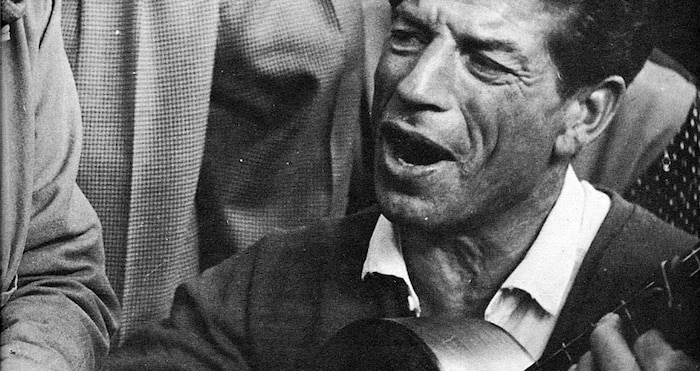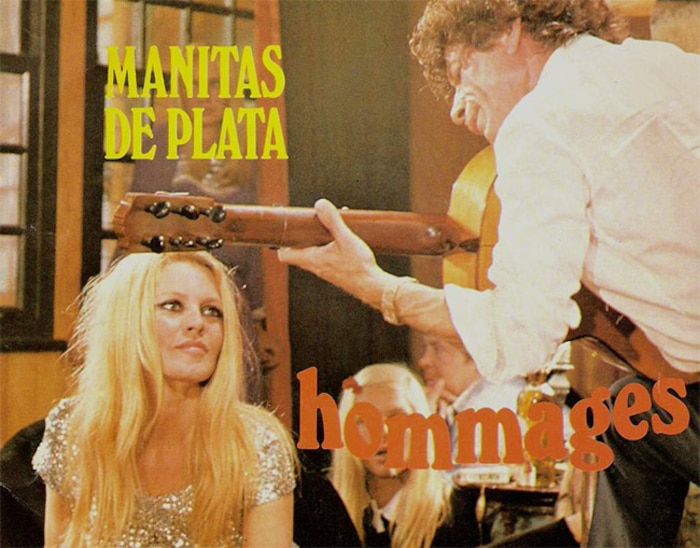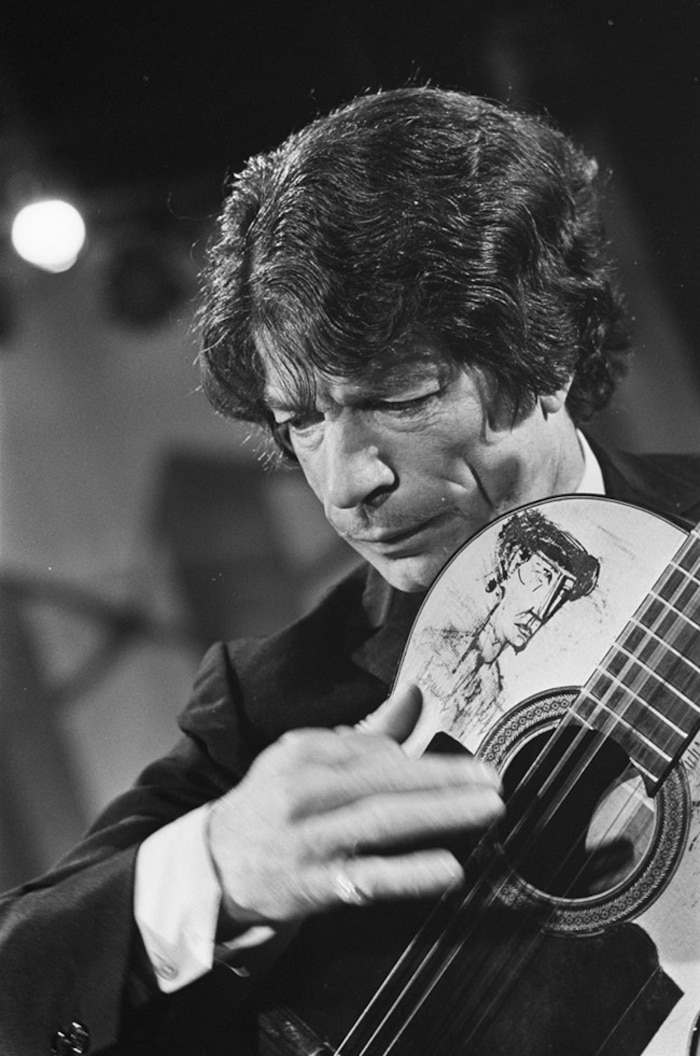RIP Gypsy Guitarist Manitas De Plata And Photographer Lucien Clergue
Garth Cartwright provides a eulogy for two men whose careers were intertwined through art.

In front of me rests an LP from 1973 called Hommages. The LP’s cover photo shows an acoustic guitarist with his back to the viewer as he intensely plays guitar while a blonde woman, only inches away, stares at him, seemingly enchanted. The women is Brigitte Bardot. The guitarist is Manitas De Plata. And the photo was taken by Lucien Clergue. These names mean less today than they did back then. Some will recall Bardot as a French movie star. Or, more recently, for her controversial political statements (a mix of pro-animal rights and anti-Islamic rhetoric), but in 1973 she was still a world famous beauty. Manitas De Plata (“little hands of silver”) is even more forgotten today. Yet across the ’60s and ’70s he sold tens of millions of albums. Lucien Clergue, meanwhile, was a widely celebrated photographer back then, famous both for his abstract nude studies and images of gypsy communities in the south of France – a photographer that earned exhibitions in New York’s Museum of Modern Art and the Louvre in Paris.

History is a cruel mistress, but it’s not an unsurprising one. (Usually.) Manitas may have commanded huge audiences internationally, but he was never a guitarist of the caliber of Django Reinhardt or Paco De Lucia. And Clergue’s best photos are unlikely to be held up as comparable to those of Cartier Bresson or Robert Capa. Yet both Manitas and Clergue once strode France as giants. And both died within a fortnight of one another in November 2014. One might consider them locked together in death as they once were in life: Clergue not only photographed Manitas but brought him to international attention. Clergue is credited with “Artistic direction” on Hommages but he was more than that – a manager and mentor who took Manitas from local fame amongst the Camargue (a swampy region south of Arles that has long been home to gypsy communities) to Carnegie Hall (where he would perform 14 times). The passing of Manitas and Clergue reflects on an earlier era of French music and art whose like we shall not see again.
Manitas and Clergue came out of a post-war France where tradition mixed with modernism. Manitas – born Ricardo Baliardo – grew up as part of a semi-nomadic gypsy community who spoke Catalan as their first language and played in a manner that disregarded the strict rules of Andalusian flamenco guitarists. He also embraced the influence of the late Parisian gypsy jazz guitarist Django Reinhardt and began to incorporate Latin American rhumba rhythms into his style. Slowly Manitas began developing a new French flamenco fusion, one that was – at the time – ridiculed by flamenco purists.
In gypsy communities across Europe music is often the only form of cultural expression available and the foremost musicians gather great status. Manitas established himself at the annual Gitan Pilgrimage that takes place in St Maries de la Mer, a working class seaside town in the Camargue. It was here in 1955 that the sound engineer Marc Aubort recorded Manitas playing. Aubort wrote to Manitas requesting permission to release the recording – unaware the guitarist was illiterate (and distrustful of recording, believing it would allow others to copy his playing).
Lucien Clergue, living in Arles and always looking for exotic subject matter, regularly attended the annual Gitan Pilgrimage and it was his photos of Manitas that brought the US record producer E Alan Silver to the Camargue in 1963 with recording equipment. Clergue convinced Manitas to the recordings and the resulting albums – 1963’s Gypsy Flamenco and 1965’s Ole – caught the imagination of a public already enchanted by Miles Davis’ Sketches of Spain and the hit 1963 film Los Tarantos (a melodrama set amongst Barcelona’s gypsies). Back then, before world music was an established genre, flamenco was seen as exotic and gypsies were viewed as having stepped straight out of Bizet’s Carmen. Manitas, craggily handsome and with an intense, wary persona, could have come straight from central casting.
With Clergue as his manager, Manitas quickly began playing major concert halls across Europe and North America. Clergue, already well connected, introduced Manitas to Pablo Picasso, Salvador Dali and Jean Cocteau and the three modern art icons all showered praise on the guitarist (Picasso even engraved a drawing of bulls and matadors on his guitar). The St Tropez set – of which Bardot was Queen – followed suit, hiring Manitas to play their parties.

Manitas did not perform solo. Accompanied by his cousin Jose Reyes on vocals and palmas (the rhythmic clapping that is flamenco’s core percussion) and his son Manero Balliardo (guitar, palmas) he became a hugely popular concert attraction and, as the ’60s progressed, began selling hundreds of thousands of albums. The likes of John Steinbeck and Marlon Brando praised Manitas and the media portrayed him as something of a noble savage – the uneducated gypsy “genius” who instinctively played long, improvised flamenco guitar pieces and cared little for money or society. At least that was how he was portrayed: another Manitas album I own finds him standing with his guitar in front of an old wooded caravan, seemingly ready to hit the road in a traditional style.
Manitas may have had little interest in conforming to polite society – it’s believed he fathered dozens of children – but he loved the money that came his way. Born in 1921, his father was a horse trader who sent his son out to beg and dance on the streets for coins. An uncle taught him guitar aged nine and he became a professional musician not long after, working cafes and restaurants or simply playing for tips on the street. When the Nazis occupied France, Manitas and his people were forced into a shadowy existence and reinforced his intense distrust of authority.
When international fame hit in the mid-’60s, Manitas suddenly found himself wealthy beyond his dreams. The money came and the money went: Manitas was suspicious of banks, so he kept his fortune in cash, squandering it on casinos, expensive cars and fast women. He also supported his extended gypsy family, handing out alms wherever he went. Yet his generosity stopped when it came to paying Jose Reyes fairly, and when the singer split from Manitas in the early ’70s he was forced to pick tobacco to support his family. Manitas also saw no reason to pay taxes and this led to the French authorities eventually blocking his earnings from royalties and copyrights. He never invested in property and lived out of a small, rented apartment in his latter decades. Even the Picasso-illustrated guitar went towards gambling debts.
Inevitably, Manitas’ time in the sun passed and by the ’80s he was a largely forgotten figure. Lucien Clergue stopped managing him and concentrated on publishing books of his photography and running the Rencontres d’Arles festival, now one of the most important dates in the photography calendar (96,000 people visited in 2013). Jose Reyes founded a band with his sons. When Reyes died, they changed their name from Los Reyes to The Gipsy Kings and went on to sell even more records and concert tickets than Manitas. The Kings never forgave him Manitas, and his role in popularizing French flamenco is something they refuse to discuss.
I never met Manitas, but I did note his arrival at every Gitan Pilgrimage I attended. He was impossible to miss: Already well into his 80s, he would arrive wearing a ridiculously flashy suit, shirt open to his navel, his long grey hair bleached and much younger women on each arm. He no longer played guitar, but people still flocked around the old icon and his weathered features still possessed a roguish charm. I did get to know Lucien Clergue and found him a charming, if unreliable, narrator. His photos of the Gitan Pilgrimage in the late ’50s and early ’60s convey a community at their most striking.
Every May the Gitan Pilgrimage takes place at St Maries de la Mer, as it has for more than two centuries now. Across two days it involves much colour – teams of horsemen accompany a tiny carving of Sarah I Kali – the “black Madonna” – and a young Gypsy woman into the sea, honouring the local legend of Mary Magdalene’s escape to these shores with a gypsy servant. The town is alive with music and dance as gypsies from across Europe gather to celebrate. Manitas will no longer be there, but the tradition that shaped him continues and the kids continue to dance on the street.